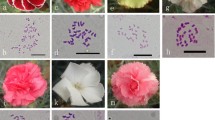Abstract
Ploidy variation within progenies from intra- and inter-ploidy crosses of asparagus were determined in this study. The DNA content of most reduced microspores was half that of somatic cells in diploid, triploid and tetraploid plants as determined by flow cytometry. Many viable seeds were obtained from various 2x × 2x and 2x × 3x intra- and inter-ploidy crosses. Nuclear DNA contents of these progenies from reciprocal crosses between diploids and triploids were similar to those expected of diploids, but with a wider range: hyper- and hypo-diploids including trisomics seem to be involved in the progenies. Indeed, the number of chromosomes in the progenies of 2x × 3x crosses ranged from 18 to 23. Based on frequencies of viable seeds and trisomic phenotypic appearance, it was concluded that the 2x × 3x cross was most efficient for obtaining trisomic plants in Asparagus officinalis.


Similar content being viewed by others
References
Adams S, Vinkennoog R, Spielman M, Dickinson HG, Scott RJ (2000) Parent-of-origin effects on seed development in Arabidopsis thaliana require DNA methylation. Development 127:2493–2502
Arumuganathan K, Earle ED (1991) Nuclear DNA content of some important plant species. Plant Mol Biol Rep 9:208–218
Biffi R, Restivo FM, Marziani GP, Spada A, Falavigna A (1995) A restriction fragment length polymorphism probe for early diagnosis of gender in Asparagus officinalis L. HortScience 30:1463–1464
Cattanach BM, Beechey CV (1997) Genomic imprinting in the mouse: possible final analysis. In: Reik W, Surani A (eds) Genomic imprinting. Oxford University Press, Oxford, pp 118–145
Goodspeed TH, Avery P (1939) Trisomic and other types in Nicotiana sylvestris. J Genet 38:381–458
Ishiki K (1991) Cytological studies on African rice, Oryza glaberrima Steud. 3. Primary trisomics produced by pollinating autotriploid with diploid. Euphytica 55:7–13
Jamsari A, Nitz I, Raemon-Büttner SM, Jung C (2004) BAC-derived diagnostic markers for sex determination in asparagus. Theor Appl Genet 108:1140–1146
Jiang C, Sink KC (1997) RAPD and SCAR markers linked to the sex expression locus M in asparagus. Euphytica 94:329–333
Jiang C, Lewis ME, Sink KC (1997) Combined RAPD and RFLP molecular linkage map of asparagus. Genome 40:69–76
Kermicle JL (1970) Dependence of the R-mottled aleurone phenotype in maize on mode of sexual transmission. Genetics 66:69–85
Kermicle JL, Alleman M (1990) Gametic imprinting in maize in relation to the angiosperm life cycle. Development [Suppl]:9–14
Khush GS (1973) Cytogenetics of aneuploids. Academic Press, London
Lesley JW (1928) A cytological and genetical study of progenies of triploid tomatoes. Genetics 13:1–43
Lewis ME, Sink KC (1996) RFLP linkage map of asparagus. Genome 39:622–627
Lin BY (1984) Ploidy barrier to endosperm development in maize. Genetics 107:103–115
Löptien D (1979) Identification of the sex chromosome pair in asparagus (Asparagus officinalis L.). Z Pflanzenzücht 82:162–173
Maestri E, Restivo FM, Marziani-Longo GP, Falavigna A, Tassi F (1991) Isozyme gene markers in the dioecious species Asparagus officinalis L. Theor Appl Genet 81:613–618
Müntzing A (1930) Über choromosomenvermehrung in Galeopsis—Kreuzungen und ihrephylogenetische Bedeutung. Hereditas 14:153–172
Nakashima T, Kunitake H, Tanaka M (1992) Intercrossing between diploid, triploid and tetraploid of Asparagus officinalis L. Jpn J Breed 42 [Suppl 1]:462–463
Nishiyama I, Inomata N (1966) Embryological studies on cross incompatibility between 2x and 4x in Brassica. Jpn J Genet 41:27–42
Nogler GA (1984) Gametophytic apomixes. In: Johri BM (ed) Embryology in angiosperms. Springer, Berlin Heidelberg New York, pp 726–730
Ozaki Y, Narikiyo K, Hiramatsu M, Ureshino K, Okubo H (1998) Application of flow cytometry for rapid determination of ploidy levels in asparagus (Asparagus officinalis L.). J Fac Agric Kyushu Univ 43:83–88
Ozaki Y, Tashiro T, Kurahashi T, Okubo H (1999) Variation of pollen viability and storability in asparagus (Asparagus officinalis L.) cultivars. J. Fac Agric Kyushu Univ 44:1–8
Park SM (2000) Studies on the aneuploidy in Grape (Vitis complex) with special reference to crosses with triploids and tetraploids. PhD Thesis, Kyushu University, Fukuoka, Japan
Punyasingh K (1947) Chromosome numbers in crosses of diploid, triploid and tetraploid maize. Genetics 32:541–554
Reamon-Büttner SM, Schondelmaier J, Jung C (1998) AFLP markers tightly linked to the sex locus in Asparagus officinalis L. Mol Breed 4:91–98
Restivo FM, Tassi F, Biffi R, Falavigna A, Caporali E, Carboni A, Doldi ML, Spada A, Marziani GP (1995) Linkage arrangement of RFLP loci in progenies from crosses between doubled haploid Asparagus officinalis L. clones. Theor Appl Genet 90:124–128
Romagosa I, Hecker RJ, Tsuchiya T, Lasa JM (1986) Primary trisomics in sugarbeet. I. Isolation and morphological characterization. Crop Sci 26:243–249
Sarkar KR, Coe EH Jr (1966) A genetic analysis of the origin of maternal haploids in maize. Genetics 54:453–464
Sarkar KR, Coe EH Jr (1971) Anomalous fertilization in diploid-tetraploid crosses in maize. Crop Sci 11:539–542
Scott RJ, Spielman M, Bailey J, Dickinson HG (1998) Parent-of-origin effects on seed development in Arabidopsis thaliana. Development 125:3329–3341
Singh RJ (1993) Plant cytogenetics. CRC Press, Boca Raton, Fla.
Surani MA, Kothary R, Allen ND, Singh PB, Fundele R, Ferguson-Smith AC, Barton SC (1990) Genomic imprinting and development in the mouse. Development [Suppl]:89–98
Takatori FH (1985) Asparagus officinalis. In: Halevy AH (ed) CRC Handbook of flowering. CRC Press, Boca Raton, Fla., pp 517–520
Tilghman SM (1999) The sins of the fathers and mothers: genomic imprinting in mammalian development. Cell 96:185–193
Valentine DH (1954) Seed incompatibility. In: Proceedings of the 8th International Botanical Congress, Paris
Wagner JJ, Ellison JH (1964) Incompatibility between diploid and autotetraploid Asparagus officinalis L. Proc Am Soc Hortic Sci 85:344–349
Wakakuwa S (1934) Embryological studies on the different seed-development in reciprocal interspecific crosses of wheat. Jpn J Bot 7:151–185
Watkin AE (1932) Hybrid sterility and incompatibility. J Genet 25:125–162
Author information
Authors and Affiliations
Corresponding author
Rights and permissions
About this article
Cite this article
Ozaki, Y., Narikiyo, K., Fujita, C. et al. Ploidy variation of progenies from intra- and inter-ploidy crosses with regard to trisomic production in asparagus (Asparagus officinalis L.). Sex Plant Reprod 17, 157–164 (2004). https://doi.org/10.1007/s00497-004-0229-5
Received:
Accepted:
Published:
Issue Date:
DOI: https://doi.org/10.1007/s00497-004-0229-5




